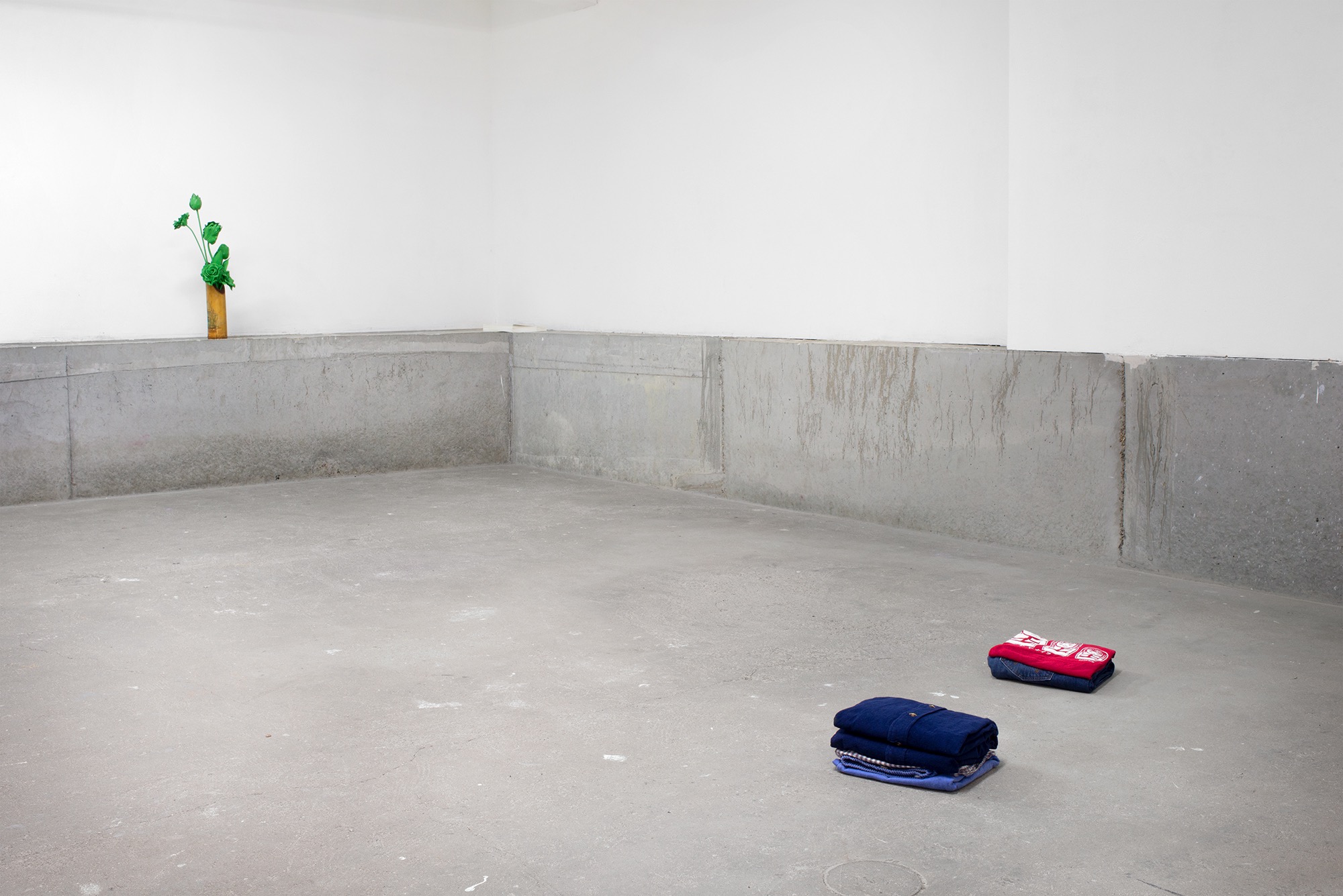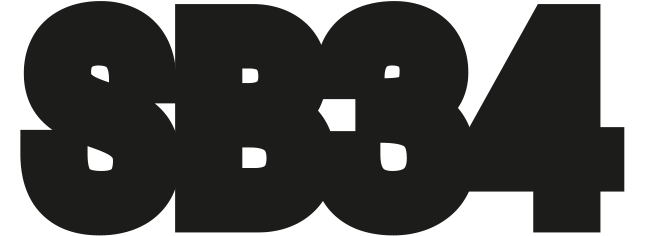






(c) Chantal van Rijt
“Me in my going out of myself (and you in yours)” deals with exchanges and relationships—from me to you and vice versa—with circulating objects and identities, fiction and artificiality, and unstable ontological statuses. From Émile Hermans to Reinier Vrancken, or the other way around, it’s a matter of becoming the other a little, of letting oneself be taken in hand so as to project unexpressed desires. In the space of SB34-The Pool, clothes are lent, flowers offered, we breathe the scent of a stranger, choose the work of a friend, project ourselves through it, and finally, with circumspection, decide on the status of what we have observed.
Reinier Vrancken and Émile Hermans begun by each choosing a specific piece from the other’s body of work. The decision of what to exhibit is delegated, revealing something of each of them in the chosen work, unveiling their reciprocal confidence in the process. Reinier Vrancken’s work Every body becoming everybody else has thus been chosen for exhibition by Émile Hermans. The work consists of a protocol to be activated: Person A is invited to give the artist a set of clothes. Person B washes them without knowing anything about Person A. A’s outfit is then exhibited folded up and smelling like B’s laundry detergent. Then B gives a set of clothes to C and so on, in an olfactive chain of cleanliness. At the end of the exhibition, the outfit is given back to its owner, with a certificate attesting to the new status it has acquired. A and B have to make a choice: either fetishise the clothes or start wearing them again, wash them, and in doing so rid them of their foreign smell—and of the artwork in the same gesture?
Transaction, exchange, and projection are also at play in Chromatonement. This work by Émile Hermans, chosen by Reinier Vrancken, consists of a bunch of artificial flowers. Hermans has dipped them in green paint, their delicate tones disappearing under the colour of a green screen. They have been dropped into an improvised vase and seem to have been forgotten there. If flowers replace awkward declarations and often make it possible to formulate the unsayable, what are they saying here? What forgiveness is being asked for? What love waits to be inserted into its projected background? Nothing indicates their intentions. Green and inalterable, mute and scentless, they are the receptacles of our unsatisfied desires.
“Me in my going out of myself (and you in yours)” permanently oscillates between two regimes of existence. The first, which is immanent, is nothing but the material make-up of the exhibition. The second, which is transcendent, is determined by the artworks’ capacity for going beyond their consistency. This aptitude is conveyed here through the story I’m producing and through the suspension of disbelief that we are offering up to you. Do you accord these relatively common if incongruously situated objects the status of artworks? Do you agree to play host to ‘the feeling, whether well-founded or not, that this object has been produced with at least partly aesthetic intention’1? Gallery, text, arguments from authority all bring into play a regime of belief that we invite you to enter into in order to transcend the flowers—almost vulgarly exhibiting their artificiality—and the pile of perfectly stacked clean clothes. Looking at these ‘aided ready-mades’, you first of all make a ‘spontaneous association’: the clothes recall the everyday, socio-cultural categories; the flowers recall an event, an intention. Exhibited together, these objects produce a new association, which issues rather from a dissociation, since the former must be effaced in order to make way for the latter. But you can decide not to go further than this habit, not worry too much about what you are looking at and think those who’ve proposed this incongruity are mad. Émile Hermans and Reinier Vrancken choose their viewers here. Those who are attentive enough to try to understand where they want to go.2 Reception is neither easy nor inactive; it’s a reflexive and productive relationship. What has been put on show is not meant to satisfy your visual pleasure but your intelligence. It’s up to you to receive what has been exhibited, to accede to it or not, to integrate and go beyond the artworks, to bring them into the moving continuity of your experience. If “Me in my going out of myself (and you in yours)” at times simulates what should be and perhaps scoffs at what is not, the exhibition invites us to think what is more than to see it. More than to see it, “Me in my going out of myself (and you in yours)” invites us to think what is, simulates at times what should be and perhaps scoffs at what is not. “Me in my going out of myself (and you in yours)” scoffs perhaps at what is not and invites us to think what is more than to see it, in order to simulate at times what should be.
Sophie Lapalu
Translated by Jack Cox
Translated by Jack Cox
Notes
O1 Gérard Genette, « La relation esthétique » (1997) dans L’œuvre de l’art, Seuil, Paris, p. 400.
O2 I’m paraphrasing Marc Decimo’s analysis of Duchamp’s ready-mades. See Marc Decimo, Le Duchamp facile, Les Presses du réel, Dijon, 2005, p. 46-47.
︎ Reinier Vrancken & Émile Hermans
B with d, p with t, m with n, v with w and f with th, 2022
rewritten exhibition text, dimensions variable
︎ Émile Hermans
Chromatonement, 2015-2022
artificial flowers, chromakey paint, dimensions variable
︎ Reinier Vrancken
Everybody becoming everybody else, 2022
Machteld’s clothes and Émile’s smell, 250 x 200 x 150mm
︎ Reinier Vrancken
Everybody becoming everybody else, 2022
Émile’s clothes and Marjolein’s smell, 250 x 200 x 150mm

︎ BIOS
Émile Hermans (1988) lives and works between Maastricht, the Netherlands, and Genk, Belgium. Solo exhibitions include A Defense at Greylight Projects (Heerlen, NL) in 2022 and Primetime at De Meldkamer (Maastricht, NL) in 2017. He has taken part in group exhibitions at Museum De Domijnen (Sittard, NL), Jester –formally known as CIAP– (Hasselt–Genk, BE), B32 artspace (Maastricht, NL), W139 (Amsterdam, NL), and Établissement d’en face (Brussels, BE). Together with partner Alicja Melzacka and three others he runs a micro artspace in Maastricht, NL.
Reinier Vrancken (1992) lives and works in Rotterdam, the Netherlands. Solo exhibitions include Ye (…) manifold at Marwan (Amsterdam, NL) in 2021 and An owl is an owl and a swan is a swan but a crow is only partially crow and partially the sound a rooster makes at KOMPLOT (Brussels, BE) in 2018. He has taken part in group exhibitions at Het Gebouw (by stanley brouwn) (Utrecht, NL), Art Rotterdam (Rotterdam, NL), Shimmer (Rotterdam, NL), Tique (Antwerpen, BE), Rib (Rotterdam, NL), Garage (Rotterdam, NL), Museum van Bommel van Dam (Venlo, NL) and Marres, House for Contemporary Culture (Maastricht, NL). In 2023 he will be artist-in-residence at WIELS (Brussels, BE).
With the kind supports of Fédération Wallonie-Bruxelles and Embassy of the Netherlands in Brussels.


